The business world is unstable and ever-changing. Changes in competition and client preferences affect every organization. So, business leaders cannot rely only on competitive advantages to continue their businesses; thus, leaders must be aware of evolving business conditions.
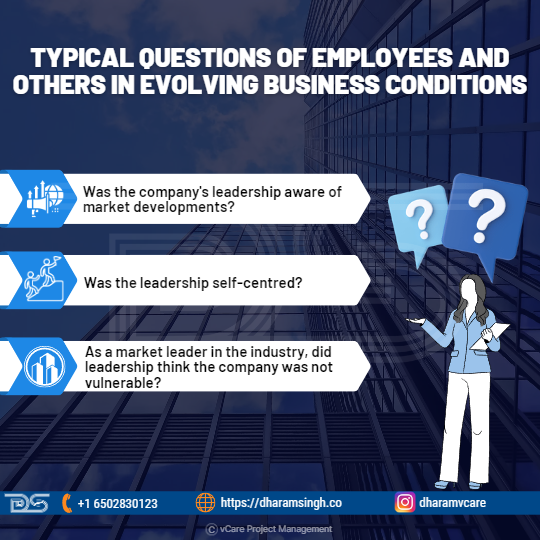
Typical questions of employees and others in evolving business conditions
The following are typical questions that employees and others in similar situations may have:
- Was the company’s leadership aware of market developments?
- Was the leadership self-centred?
- As a market leader in the industry, did leadership think the company was not vulnerable?
Project/Program/Portfolio managers may help firm leadership by developing situational awareness and emotional intelligence to deliver essential leadership.
- The portfolio manager must understand the enterprise’s situational awareness.
- The program manager analyses the program for strategic goals and enterprise understanding and how the projects may be appropriately implemented as a program.
- The project manager must identify which strategic aim the project will assist in implementing or will accomplish.
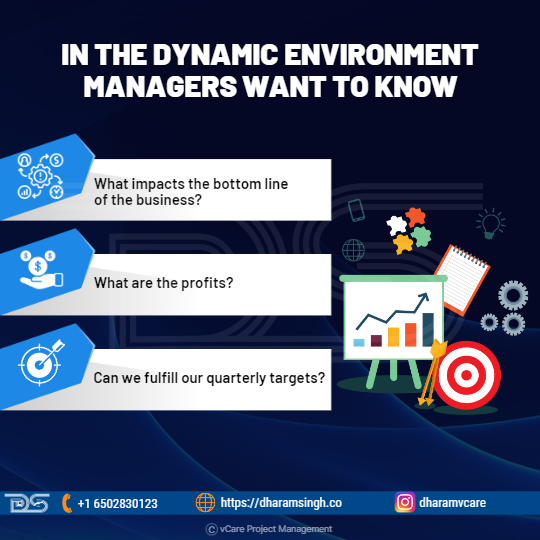
In the dynamic environment managers want to know
Understanding the professional environment helps project leaders comprehend the politics of their projects. In today’s high-pressure, dynamic environment, managers want to know the following:
- What impacts the bottom line of the business?
- What are the profits?
- Can we fulfill our quarterly targets?
The project management professional must have the emotional intelligence to understand the company’s situation. Those unable to comprehend emotions, influence a project, program, or portfolio, and have a high emotional intelligence quotient are more likely to be attentive to how essential stakeholders perceive their competence.

Situational Awareness
Situational Awareness
Situational awareness is defined as “the perception of the elements in the environment in a volume of time and space, the comprehension of their meaning, and the projection of their status shortly.”
In many project management scenarios, situational awareness is essential for success. It is the capacity to observe what is happening around you and understand how it will affect your endeavor. Situational awareness is based on a simple observation. The tools, techniques, behaviors, and approaches that work well in one scenario may not work well in another. Simple best practices may sometimes be appropriate for the context and result in a positive conclusion; other times, they may result in disaster.
Emotional intelligence and situational awareness are skills that could be taught. However, situational awareness is a dynamic, ever-changing process, not a linear one. Depending on how the scenario progresses and one’s capacity to integrate existing information in the ongoing observation, interpretation, projection, and prediction process, one may have excellent situational awareness one moment and severely poor situational awareness the next. As a result, constant practice and training are required for portfolio, program, and project leadership skills in both emotional intelligence and situational awareness.
Situational Leadership
The Situational Leadership approach established by Paul Hersey and Ken Blanchard is a useful technique for project leaders to employ when choosing a leadership interaction style.
The core premise of situational leadership theory is that there is no single “best” leadership technique. Instead, effective leadership is task-relevant, and the most successful leaders adapt their leadership style to maturity (“the capacity to set high but attainable goals, willingness and ability to take responsibility for the task, and relevant education and experience of an individual or a group for the task”) of the individual or crowd they are trying to lead or influence. Effective leadership changes not just with the individual or group being influenced but also with the task, job, or function that needs to be completed.
The Situational Leadership approach can assist you in developing relationships with your team members since you will tailor your leadership style to their degree of development. Each team member necessitates a specific amount of hands-on, communication-based leadership. It is up to you to evaluate your team members’ skills, confidence, and motivation and to decide which leadership style to employ.
Every team member has different abilities, degrees of confidence, and motivation levels at work. Some team members may like your leadership, while others will feel underserved if you employ the same leadership approach for everyone. The Situational Leadership method is adaptable, allowing you to tailor your leadership style to match the demands of everyone.
The key to Situational Leadership is determining the followers’ readiness level. Readiness is classified into four categories based on the followers’ motivation and ability to complete the assigned project activity.
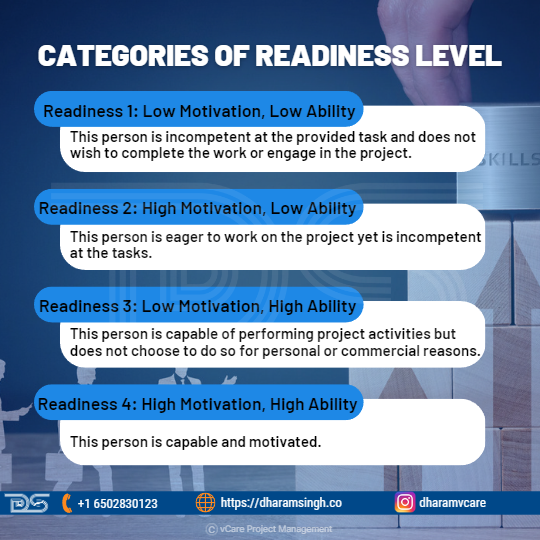
Categories of readiness level
Readiness 1: Low Motivation, Low Ability – This person is incompetent at the provided task and does not wish to complete the work or engage in the project.
Readiness 2: High Motivation, Low Ability – This person is eager to work on the project yet is incompetent at the tasks.
Readiness 3: Low Motivation, High Ability – This person is capable of performing project activities but does not choose to do so for personal or commercial reasons.
Readiness 4: High Motivation, High Ability – This person is capable and motivated.
Situational Theory of Leadership
Situational leadership theory assumes that the most successful leadership style varies depending on the context. Therefore, a leader must be able to change his style and approach to the evolving conditions to be most effective and successful.
Some employees, for example, perform better under a more dictatorial and directive CEO. Others will be more likely to succeed if the leader can step back and allow his team to make choices and carry out plans without his direct participation. Similarly, not all sectors and corporate contexts need the same abilities and leadership attributes.
Hersey and Blanchard’s Situational Leadership Theory
The term “situational leadership” is most generally associated with the Situational Leadership Theory developed by Paul Hersey and Ken Blanchard. This leadership strategy indicates that two main factors must be adequately matched: the leader’s leadership style and the followers’ maturity or preparation levels.
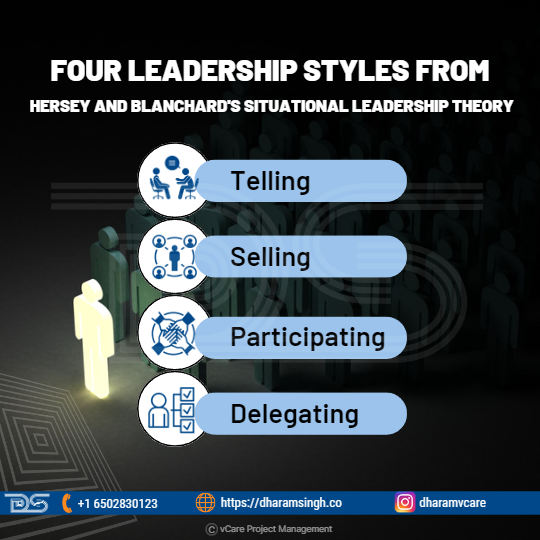
Four leadership styles
The theory recognizes four primary leadership styles:
- Telling (S1): Leaders must provide close supervision and precise directions to team members on what to do and how to accomplish it. When working with team members who are unwilling or unmotivated and need more knowledge and abilities, Style 1 is excellent.
- Selling (S2): The leader explains their decisions and allows team members to raise questions. Style 2 is best suited to followers who are driven to finish the work despite a lack of necessary information or skills.
- Participating (S3): Team members are encouraged to provide ideas and participate in decision-making. Style 3 suits followers with the necessary knowledge and skills to finish a task but who need more drive or motivation.
- Delegating (S4): The leader delegated greater responsibility to team members, allowing them to take ownership of the work. When dealing with high-commitment team members who are highly skilled and driven, Style 4 is acceptable since they have the knowledge, abilities, and desire to finish the assignment without much input from the leader.
While knowing the different situational leadership styles is important, their implementation may determine how effective a leader seems to their team. Examine its impact on team loyalty and the qualities of effective situational leaders.
The qualities of situational leaders
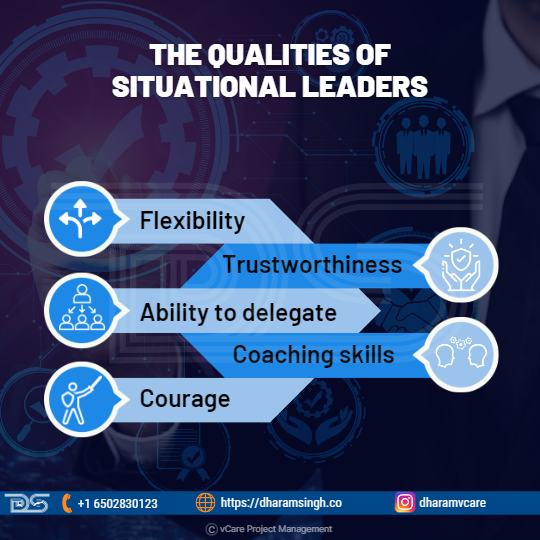
The qualities of situational leaders
- Flexibility: Situational leaders are adaptable enough to change their approach depending on the level of growth of each team member.
- Trustworthiness: Good situational leaders are capable of acquiring the trust of others.
- Ability to delegate:You must be able to delegate successfully to team members with high levels of competence and commitment to employ the situational leadership approach.
- Coaching skills: When working with team members who lack confidence or ability, one must deliver clear directions for task accomplishment.
- Courage: It takes courage to change your leadership style when everyone else is comfortable with the same stale approach.
Situational Leadership: Team Development
Situational leadership is a wonderful way of establishing your team. But first, figure out how you’ll address the learning needs of your project team members, who make up your core team.
Leadership team development provides your core project team with the abilities necessary to complete the duties assigned to them. As a situational leader, you can examine what is needed at any given time. One of the most critical areas to concentrate on is assisting the team in overcoming complacency.
Final Thoughts
Successfully using the situational leadership theory is an excellent method for becoming a competent leader. The idea divides leadership into several parts, explains each, and makes it simpler to increase one’s leadership skills successfully. It also demonstrates that leadership skills may be developed with appropriate training.
Situational leadership is a concept that may help any company, especially those that are already successful, enhance its performance and development. However, when done right, incorporating situational leadership into daily operations cannot affect a company. Instead, it can only help the company’s employees and, thus, its growth.
Finally, a leader must first come to know the employees to lead and inspire them successfully. Understanding leadership and motivation is the theoretical cornerstone of being a successful leader, but knowing one’s followers is equally important. To properly apply leadership and motivating concepts, leaders must understand their members’ personalities, cultural backgrounds, and developmental levels. Frequent personal interaction with their employees is the best way for a leader to get to know them, which is quickly done when the leader becomes a team member.
Feel free to check out my discussion on this topic with Justin Buckwalter in YouTube
For any questions related to your Project Management career, training, and certifications, you can book an obligation free 15 minutes session with me by visiting talktodharam.com
You can subscribe to the vCare Project Management YouTube Channel to catch future videos of our Q&A series and certification success stories: https://bit.ly/2YF0wJl
You can subscribe to and follow my podcasts and interviews with Project Management Experts on YouTube at https://bit.ly/2NDY8wd



Recent Comments